Discover 20 hidden attractions, cool sights, and unusual things to do in Hildesheim (Germany). Don't miss out on these must-see attractions: Hildesheim Cathedral, Schloss Marienburg, and St. Michael's Church. Also, be sure to include Roemer- und Pelizaeus-Museum in your itinerary.
Below, you can find the list of the most amazing places you should visit in Hildesheim (Lower Saxony).
Table of Contents
Hildesheim Cathedral
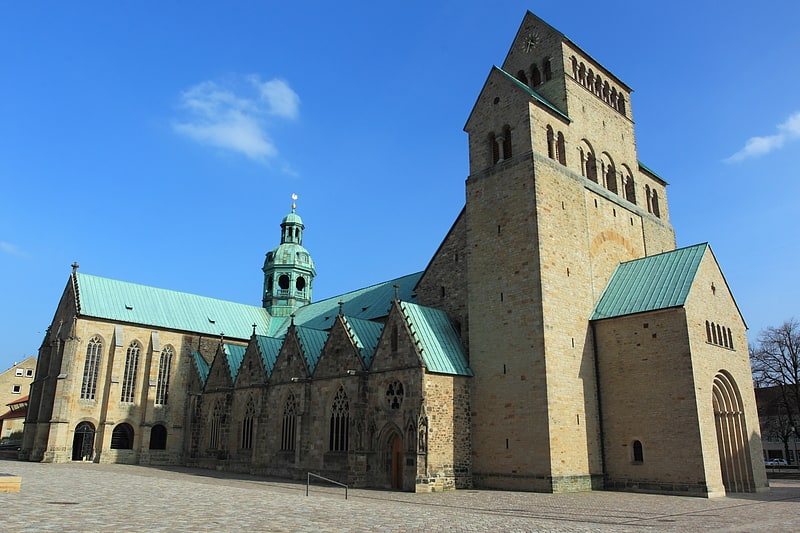
Also known as: Hildesheimer Dom
11th-century church filled with artworks. Hildesheim Cathedral, officially the Cathedral of the Assumption of Mary or simply St. Mary's Cathedral, is a medieval Roman Catholic cathedral in the city centre of Hildesheim, Germany, that serves as the seat of the Diocese of Hildesheim. The cathedral has been on the UNESCO World Cultural Heritage list since 1985, together with the nearby St. Michael's Church.
The cathedral church was built between 1010 and 1020 in the Romanesque style. It follows a symmetrical plan with two apses, that is characteristic of Ottonian Romanesque architecture in Old Saxony. The cathedral's treasures include world-famous artworks, bronze works from the time of Bishop Bernward, Bernward Doors and Bernward Column, as well as two of the four notable Romanesque wheel chandeliers: the Hezilo chandelier and the Azelin chandelier.
After renovations and extensions in the 11th, 12th and 14th centuries, the cathedral was completely destroyed during an air raid on 22 March 1945 and rebuilt from 1950 to 1960. A thorough renovation of the cathedral began in 2010, including technical and conservation measures. Some of the cathedral's treasures have been shown further afield, including at an exhibition at New York's Metropolitan Museum of Art. The cathedral was reopened on 15 August 2014.[1]
Address: Domhof 17, 31134 Hildesheim
Schloss Marienburg
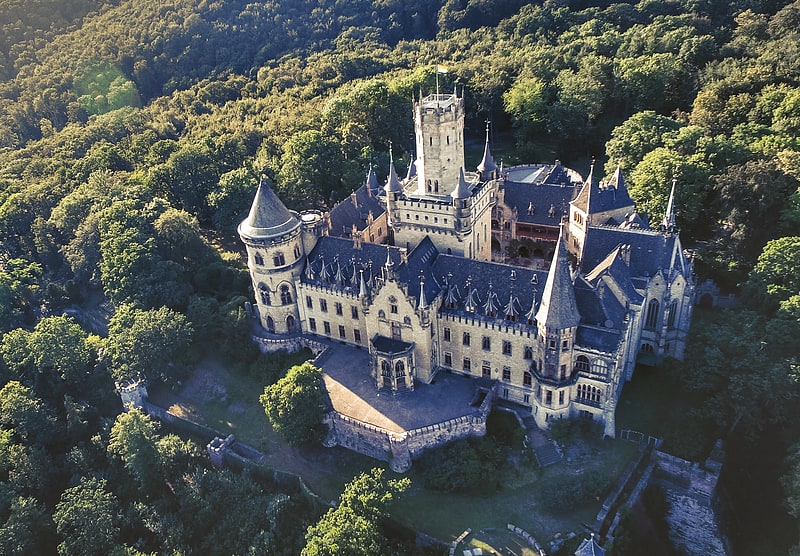
19th-century castle with guided tours. Marienburg Castle is a Gothic revival castle in Lower Saxony, Germany. It is located 15 kilometres north-west of Hildesheim, and around 30 kilometres south of Hannover, in the municipality of Pattensen, Hannover. It was also a summer residence of the House of Welf whose flag flies on the main tower.[2]
Address: Marienberg 1, 30982 Pattensen
St. Michael's Church
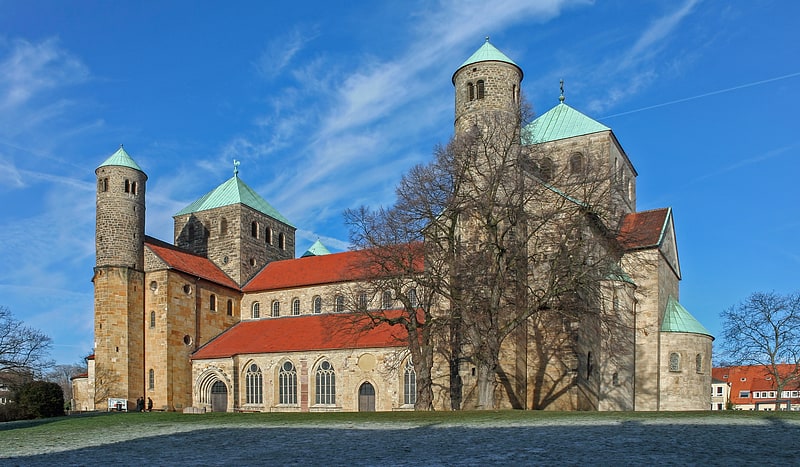
Also known as: St. Michael
Early Romanesque-style basilica. The Church of St. Michael is an early-Romanesque church in Hildesheim, Germany. It has been on the UNESCO World Cultural Heritage list since 1985. It is now a shared church, the main church being Lutheran and the crypt being Roman Catholic.[3]
Address: Michaelisplatz 2, 31134 Hildesheim
Roemer- und Pelizaeus-Museum
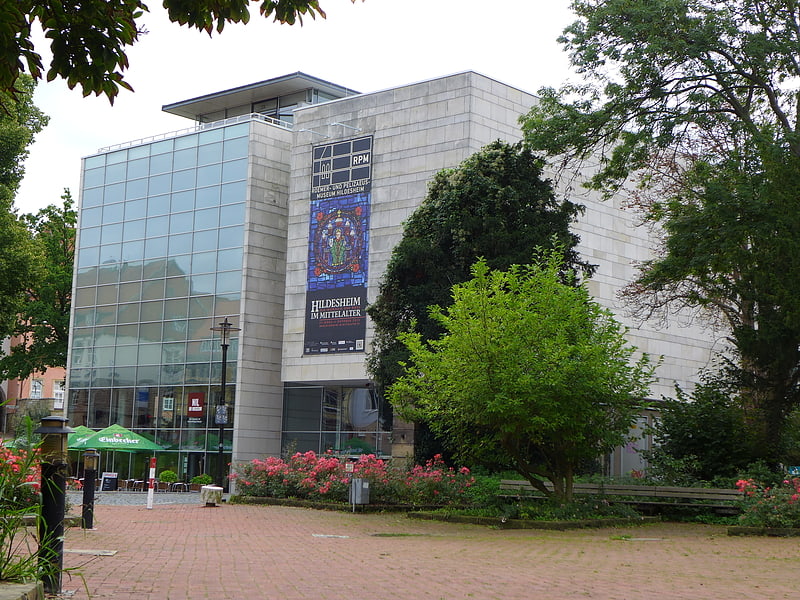
Modern museum housing ancient treasures. The Roemer- und Pelizaeus-Museum Hildesheim is an archaeological museum in Hildesheim, Germany. Mostly dedicated to ancient Egyptian and ancient Peruvian art, the museum also includes the second largest collection of Chinese porcelain in Europe. Furthermore, the museum owns collections of natural history, ethnology, applied arts, drawings and prints, local history and arts, as well as archeology. Apart from the permanent exhibitions, the museum hosts temporary exhibitions of other archaeological and contemporary topics.
In 2000, the old building, originally built in the 1950s, was replaced by a new building, significantly increasing the space available for exhibitions.
The current museum is the result of the union of the Roemer Museum, founded in 1844 (and named after one of the founders, Herrmann Roemer), and the Pelizaeus Museum, established in 1911, that had housed the private collection of Egyptian antiques of Wilhelm Pelizaeus.[4]
Address: Am Steine 1, 31134 Hildesheim
St. Andreas
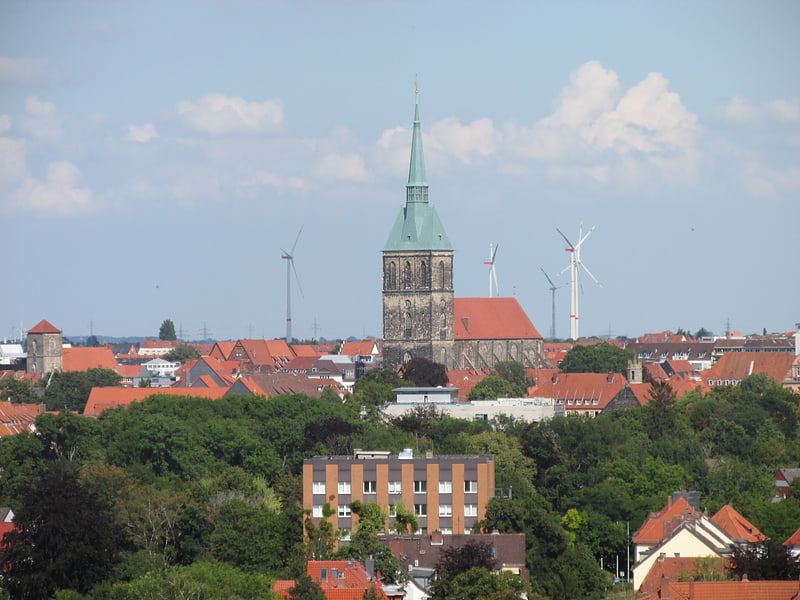
Prominent church with tower views. The church of St. Andreas is the principal Lutheran church of Hildesheim, Germany, not to be confounded with the Catholic Hildesheim Cathedral. Its tower is 114.5 metres tall, making it the tallest church tower in Lower Saxony; it is accessible and offers a panoramic view of both the city and surrounding countryside.[5]
Address: Andreaspl. 5, 31134 Hildesheim
Historic Market Place
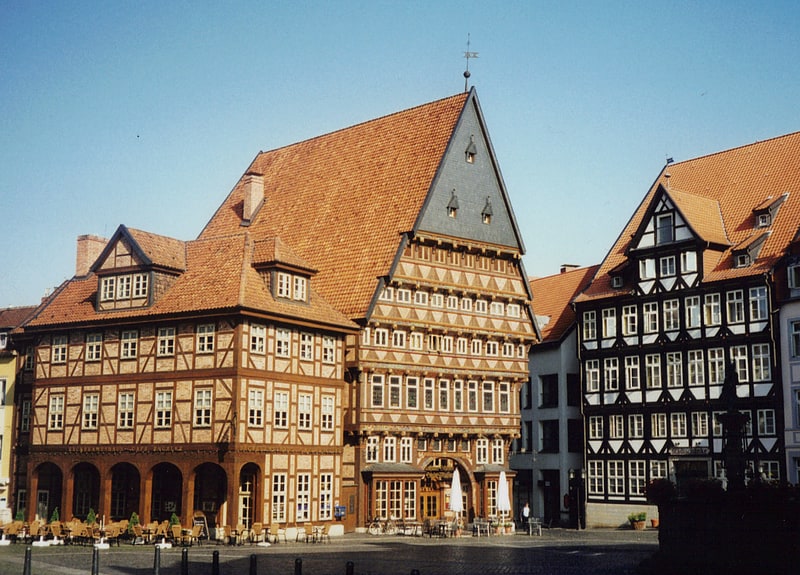
Historical landmark in Hildesheim, Germany. The Historic Market Place is a historical structure in the city of Hildesheim in Lower Saxony, Germany[6]
Hildesheim Cathedral Museum
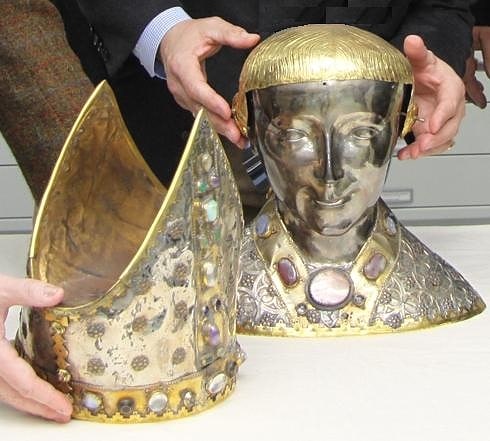
Also known as: Dommuseum Hildesheim
Museum in Hildesheim, Germany. The Hildesheim Cathedral Museum is the treasury and diocesan museum of Hildesheim, which illustrates over a thousand years of art and church history in Lower Saxony. It is located in historic rooms off the southern transept of the Hildesheim Cathedral. During the cathedral renovations of 2010, the nearby church of St Antonius and part of the cathedral cloisters were converted into display rooms for the museum.
The Hildesheim cathedral treasury is a collection of liturgical vessels, vestments, reliquaries, books and artworks of the highest quality, which has developed over the centuries. The Hildesheim Reliquary of Mary dates back to the beginning of the diocese and is connected to the cathedral's foundation story. Especially valuable pieces, including the gem-studded Cross of Bernward, the Bernward gospels, and the Ringelheim cross, were created during the prosperity of the diocese under Bishop Bernward († 1022), while the Ratmann Sacramentary was created in 1159 in connection with the beginning of his veneration as a saint. A bust reliquary and an arm reliquary of St Bernward date from the thirteenth century. From the baroque period comes magnificent monstrances and other gold and silver artworks. Many of these treasures are used to this day on important occasions in the cathedral calendar.
The Gobelins Artemisia came into the possession of the cathedral in 1727. It is being restored until 2015 and will have its own room in the reopened museum.
The efforts of Bishop Eduard Jakob Wedekin († 1870) converted the cathedral museum into a diocesan museum, containing religious artworks of the whole diocese and beyond. In particular he brought Gothic works from the parishes and his private collection into the cathedral treasury and organised their proper storage and display.[7]
Address: Domhof 18-21, 31134 Hildesheim
St. Godehard
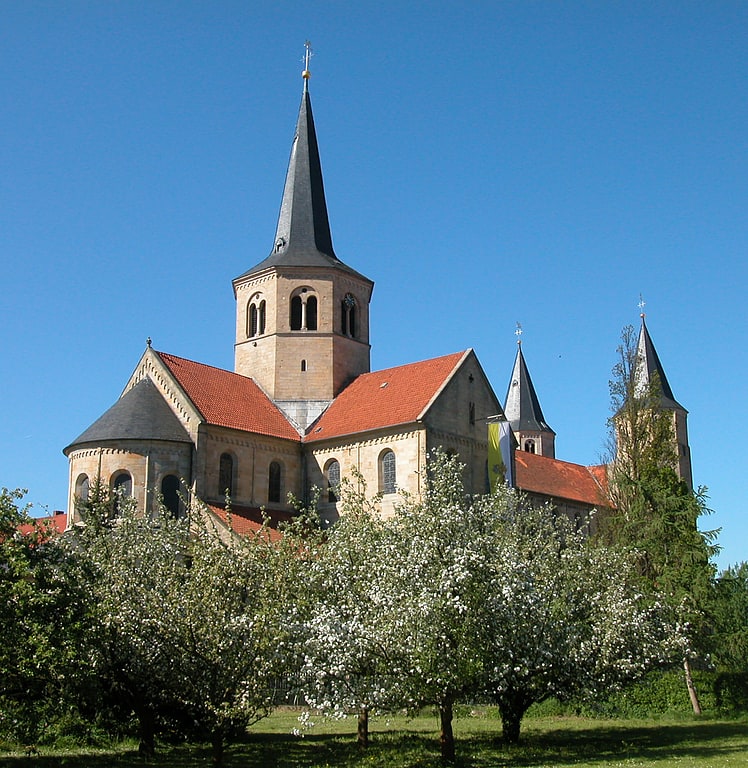
Catholic church in Hildesheim, Germany. St. Godehard is a Romanesque church in Hildesheim, Germany, formerly the church of a Benedictine abbey. It remained almost unaltered through the centuries and was not damaged much in World War II. In 1963, it was awarded the title of a Basilica minor by Pope Paul VI. It is a church of the Catholic parish Heilig Kreuz. The basilica has served as the "cathedral" of the bishop of Hildesheim from 1945 to 1960, when the Hildesheim Cathedral was destroyed and rebuilt, and from 2010, when restoration of the cathedral began. The Hezilo chandelier was installed in St. Godehard during the restoration time.[8]
Address: Godehardspl. 5, 31134 Hildesheim
St. Lamberti
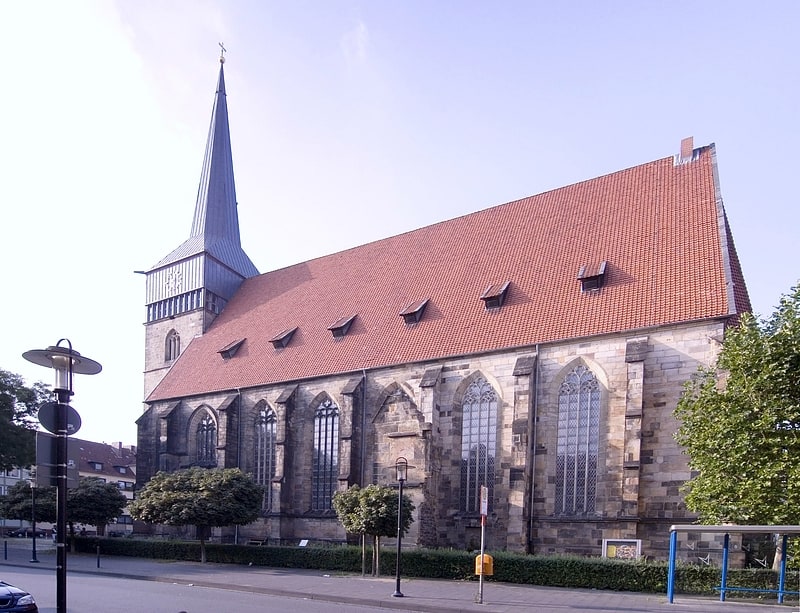
Evangelical church in Hildesheim, Germany. St. Lamberti is a parish and church in Hildesheim, Germany, the parish of the town's Neustadt. It is named after Lambert of Maastricht, the patron saint of Hildesheim. The church is a late Gothic building, the only hall church of the town. Since the Reformation, it has been a Lutheran parish church. It is situated in the Goschenstraße, on the Neustädter Markt.[9]
Address: Neustädter Markt 26, 31134 Hildesheim
St. Bernward's Church
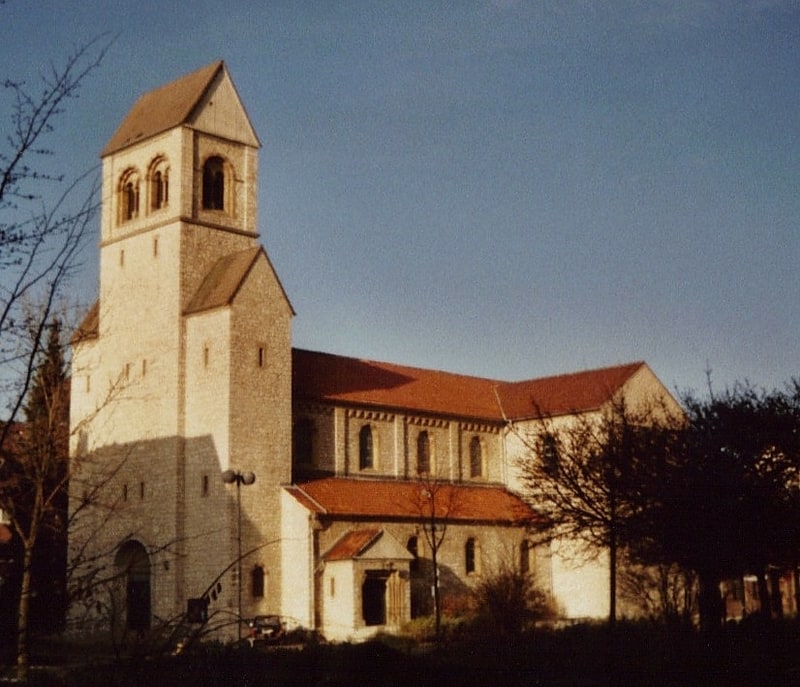
Also known as: St. Bernward
Catholic church in Hildesheim, Germany. St. Bernward's Church is a Catholic church in the city of Hildesheim in Lower Saxony, Germany. The name refers to the bishop Bernward of Hildesheim who was canonized by Pope Celestine III.[10]
Address: 19 Linkstraße, Hildesheim
Magdalenengarten
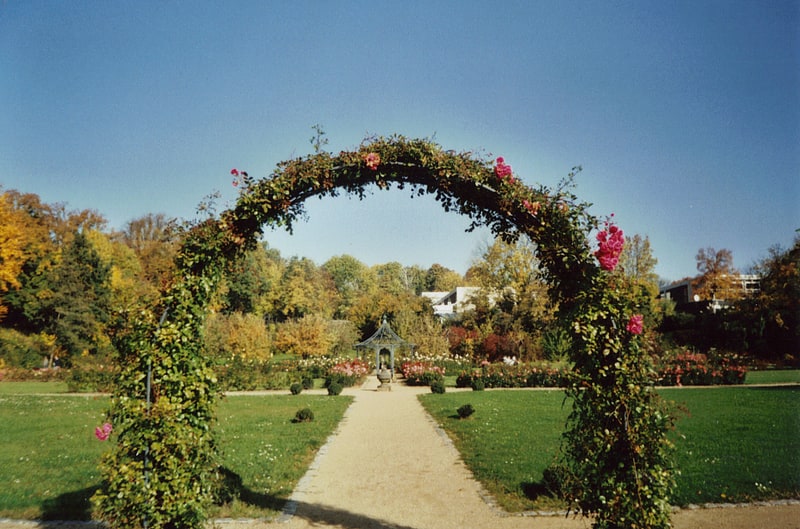
Garden in Hildesheim, Germany. Magdalenengarten is a baroque park in Hildesheim in Lower Saxony, Germany.[11]
Kloster Marienrode
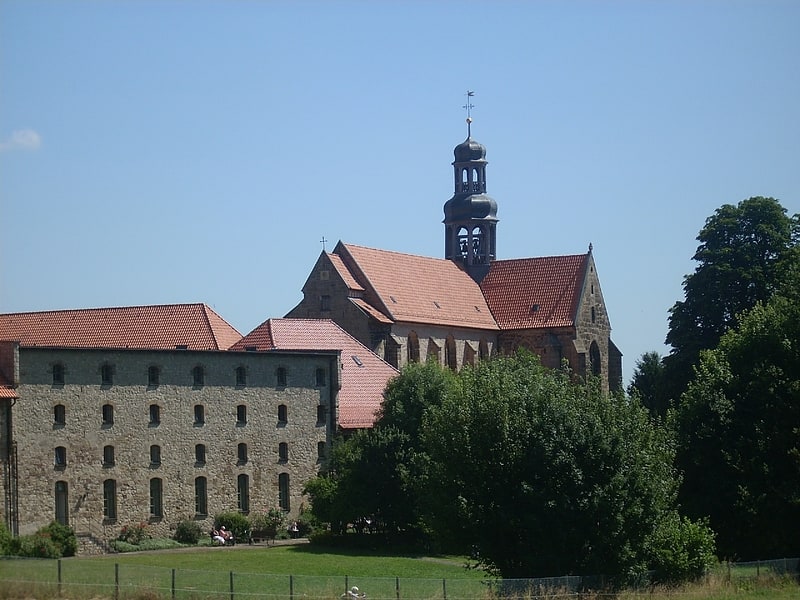
Monastery in Hildesheim, Germany. Marienrode Priory is a Benedictine nunnery in Marienrode, a district of Hildesheim in Germany.
An Augustinian monastery was founded here in 1125 by the Bishop of Hildesheim, Berthold I von Alvensleben, in a place then known as Baccenrode. It lasted until 1259. The site was re-settled later, at first by Augustinians and afterwards as a Cistercian monastery. The Cistercians gave the community its current name of Marienrode which has officially been used since 1439. The foundation stone of the present church was laid in 1412. The church was built in gothic style with three naves and completed in 1462. The Baroque ridge turret was added in the 18th century. In the church, there are two noteworthy baroque altars dating from 1750 approximately and a gothic sandstone sculpture of Saint Mary which was made in 1460. The organ dates from the middle of the 18th century. Most of the present buildings of the monastery consisting of sandstone were built in the 18th century. In the inner court there is a noteworthy pigeon tower. After the secularization of 1806, the monastery was used as a farm until 1987.
A small chapel of the priory, Saint Cosmas and Damian, which was built in 1792 was converted into a small Protestant church in 1830. It is not only used by the Protestants living in Marienrode, but also by those from Neuhof and Hildesheimer Wald, two districts of Hildesheim which do not have churches. The altar dates from 1835 and the organ from the end of the 18th century. According to Cistercian tradition, the chapel has a ridge turret instead of a tower.
From 1983, the new Bishop of Hildesheim, Josef Homeyer, was active in the re-establishment of monastic houses. As a result, Marienrode Priory was re-settled by ten Benedictine nuns from Eibingen Abbey on 5 May 1988. Since 1998, Marienrode has been an independent priory within the Beuronese Congregation.
Around the priory, a small village (Marienrode) developed which was incorporated into Hildesheim in 1974. The former village school which was operated by the priory was built in 1716. The windmill of Marienrode was built in 1839 and used as such until 1939. From the village it can be reached through a tree-lined avenue consisting of 200-year-old lindens, with a historic pavement. The large fishpond in the South of the village was laid out by the Cistercians in the Middle Ages.[12]
Address: Auf dem Gutshof, 31139 Hildesheim
St.-Mauritius-Kirche
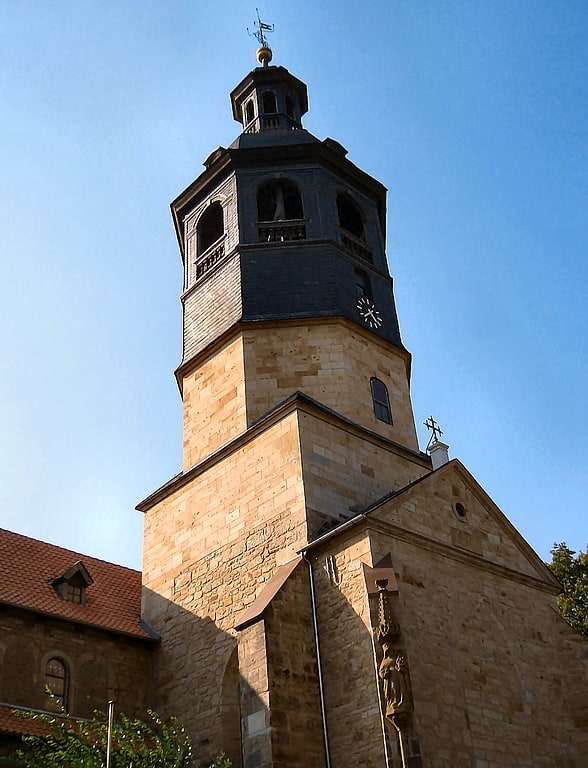
Also known as: St. Mauritius
Catholic church in Hildesheim, Germany. Stiftskirche St. Mauritius is a Catholic church on the Moritzberg in Hildesheim, Germany. The early Romanesque basilica built in 1058–1072 has been preserved without any major changes. The interior has been Baroque since the 18th century. The cloister is one of the city's most peaceful squares. Under the church is an impressive crypt, also used for church services.[13]
Address: Stiftskirchenweg 5, 31139 Hildesheim
Marienburg Castle
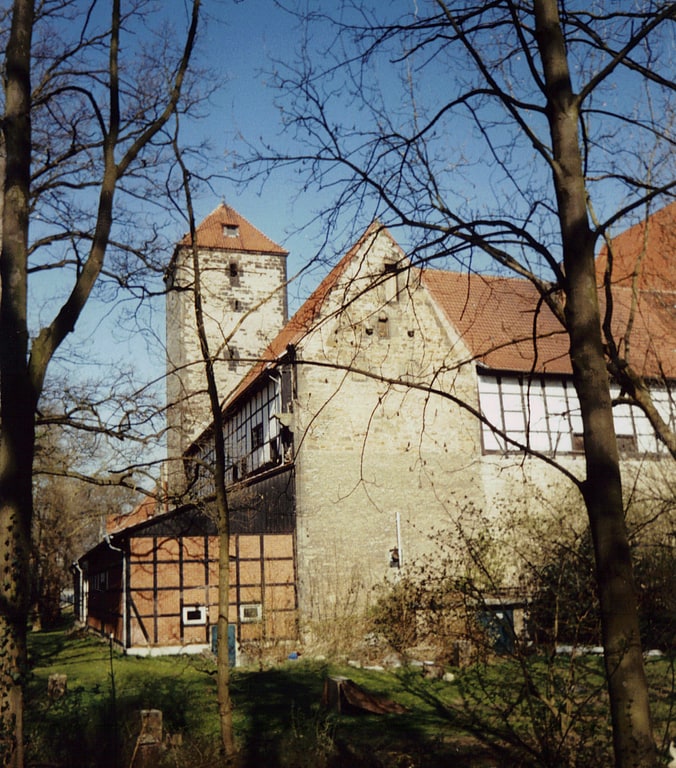
Also known as: Marienburg
Marienburg Castle is a well-preserved Romanesque castle in Hildesheim, a city in Lower Saxony, Germany.[14]
St. Magdalenen
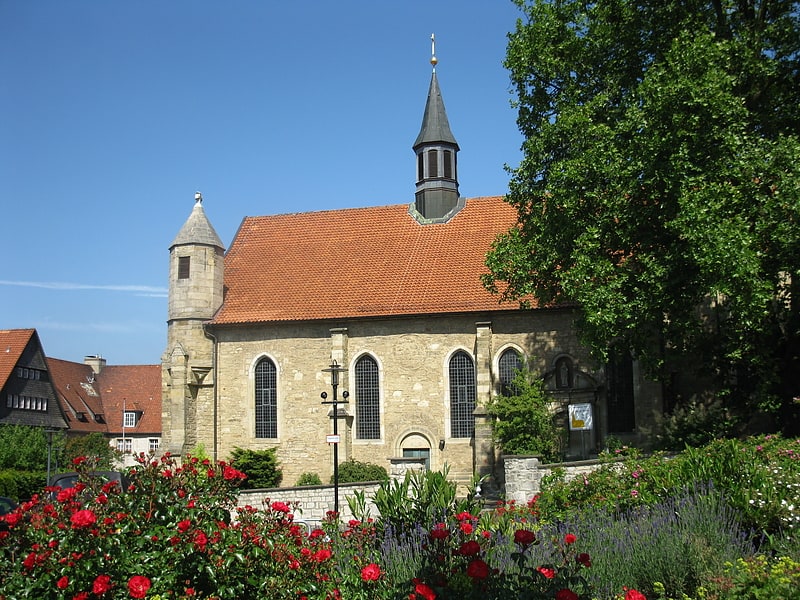
Catholic church in Hildesheim, Germany. The Magdalenenkirche or St. Magdalenen is one of the churches in Hildesheim, Lower Saxony, Germany. The Magdalenenkirche is a Catholic church that was once a monastery church, and is situated in the old town at 25 Mühlenstraße.
Founded in 1224, the current building was consecrated in 1294, the first Gothic building in Hildesheim. Extensive rebuilding took place in the 15th century and further additions were made in the 19th century. In the fifteenth century (ca. 1416) an altarpiece was created by an unknown artist, referred to as the Meister des Göttinger Barfüßeraltars depicting scenes from the life of Mary Magdalene (Magdalenenlegende). This has since been broken up and various panels are found in different museums. One of these, the Noli me tangere is in the Staatsgalerie Stuttgart.
The church was badly damaged in World War II on 22 March 1945 and partly restored in a simplified manner. The restoration was completed in 1961. Magdalenengarten, a baroque park laid out 1720–25, is close by. The small street Süsternstraße beside the church features a well-preserved part of the medieval city wall with a round tower.[15]
Address: Mühlenstraße 23, 31134 Hildesheim
Bernward Monument
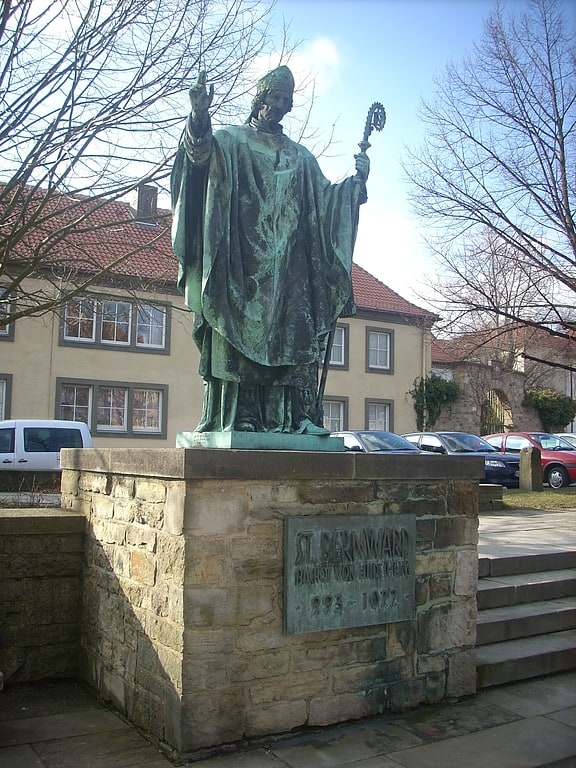
Also known as: Bernwardsdenkmal
The Bernward Monument is a larger-than-life-sized bronze statue of Bishop Bernward of Hildesheim in the Domhof in Hildesheim. It was made by Ferdinand Hartzer in 1893 for the nine hundredth anniversary of St. Bernward's enthronement as Bishop of Hildesheim. On 7 September 2011, in the course of the renovations of Hildesheim Cathedral it was temporarily relocated to the garden of house 24, Domhof.[16]
Hospital of the Five Wounds
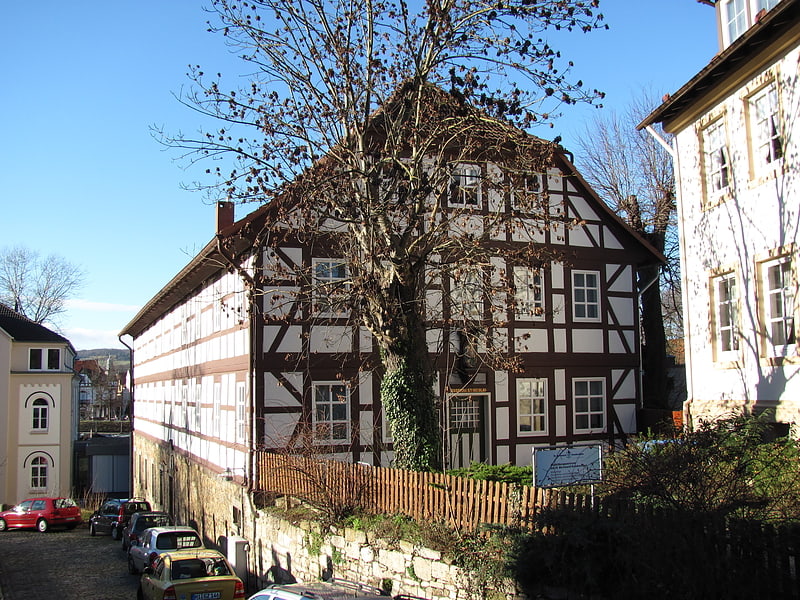
The Hospital of the Five Wounds is a half-timbered house in the city of Hildesheim in Lower Saxony, Germany. It is in the southern part of the old city center, opposite St. Godehard and behind St. Nicolai's Chapel.[17]
Thousand-year Rose

Also known as: Tausendjähriger Rosenstock
The Thousand-year Rose is also known as the Rose of Hildesheim. It grows on the apse of the Hildesheim Cathedral, a Catholic cathedral in Hildesheim, Germany, that is dedicated to the Assumption of Mary. The cathedral and the adjacent St. Michael's Church have been on the UNESCO list of World Heritage Sites since 1985.
The rose that climbs on the wall of the cathedral's apse is believed to be the oldest living rose in the world. A wild dog rose (Rosa canina), it grows against the eastern apse of the cathedral, which is around 21 m (69 ft) high and 9 m (30 ft) wide. The rose bush reaches a height of around 10 m (33 ft) and documentation verifies its age at around 700 years. Slight variations arise in the tale of the establishment of the diocese by King Louis the Pious at Hildesheim in 815 but the rose bush is a common theme in all versions. The cathedral was destroyed by Allied bombers in 1945 during the Second World War, but the roots of the rose bush survived and it blossomed again among the ruins. According to legend, while the rose bush flourishes, Hildesheim will prosper.
A poem about the rose was published in 1896. In the early twentieth century, after visiting the cathedral and seeing the rose, author Mabel Wagnalls was inspired to write a book, which went on to form the basis of a silent film.[18]
Schloss Derneburg / Hall Art Foundation
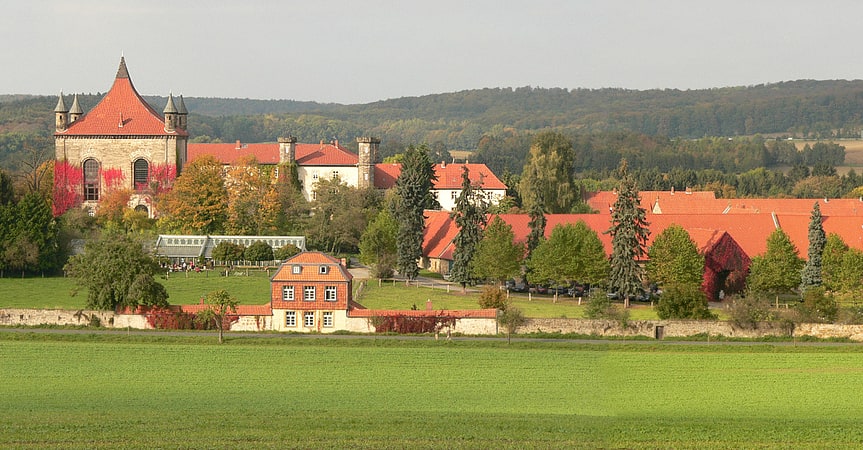
Derneburg - a town in the Holle commune in Lower Saxony. The monastery rebuilt in the 19th century into the castle. Ponds founded by religious are protected as "Mittleres Innerstetal Mit Kahnstein". The work of the architect Laves presents the path "Laves-Pfad".
Address: Schlossstraße 1, 31188 Holle; visitor center: Astenbeck 42, 31188 Holle, Hildesheim
Gelber Stern
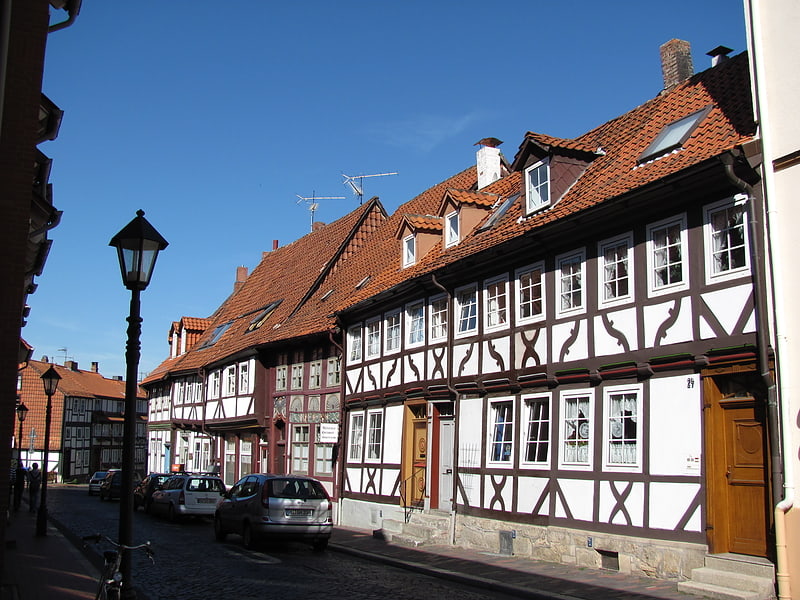
Gelber Stern is a historic street in Hildesheim, a city in Lower Saxony in Germany.[19]